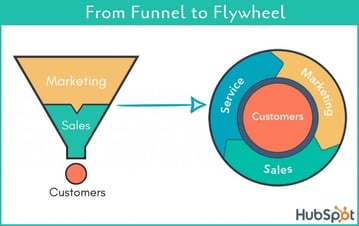For years, the sales funnel model dominated in sales and marketing. It sat at the center of entire business strategies. Marketers swore by the practical phases of awareness, interest, evaluation, decision, and purchase. But in today’s consumer-driven reality, the funnel falls short. As customer referrals and word-of-mouth gain influence in the purchase process, smart marketers are moving away from the funnel.

The main reason the funnel falls short is that it focuses on capturing customers but not on keeping them. Whatever momentum you build up during the customer journey is lost at the bottom, and you start over.
The flywheel model, on the other hand, consistently builds upon itself with the momentum created in one customer-centric stage feeding the next. If you’re missing out on repeat business or suffering from low referral rates, consider the flywheel method.
What is the Flywheel and How Does it Work?
Like the funnel, the flywheel model is based on a real-life object. James Watt invented the flywheel over 200 years ago and, thanks to its super energy efficiency, it’s still used on cars and trains today. The flywheel is comprised simply of a wheel or disc on an axis. It stores energy based on its size, speed of motion, and the amount of friction encountered.
The major benefit of the flywheel as a sales model is that it’s continuous. It facilitates circular, and thus constant, momentum in your business that acknowledges the importance of customers throughout the business cycle.
In the flywheel, customers lie at the center of your sales, marketing, and service processes. You use the momentum of your happy customers to drive referrals and repeat sales. Basically, your business keeps spinning and stays in constant motion.
Attract, Engage, Delight
As an inbound marketing methodology that puts customers first, the flywheel model seeks to attract, engage, and delight at every stage of the customer journey. This means all teams are invested in customer experience, not just your marketing and sales force. The result is a seamless and ultimately more positive experience for customers and anyone else who interacts with your business.
Here’s how this might look when it comes to assets:
Attract: Referrals, paid ads, videos, testimonials, broad educational content
Engage: Interactive content, how-tos, email marketing, chatbots
Delight: Ongoing customer support, follow-ups, incentives to shop again or refer friends
Customers as an Accelerant to your Business
Keeping existing customers is more cost-effective than finding new ones. The biggest threat to your company’s growth isn’t your competition - it’s bad customer experience. The flywheel recognizes these facts by putting customers at the core. By empowering the customers at the core, the flywheel spins faster - much like how the wheels on a car work.
When you seek to attract, engage, and delight at every phase, you put customers to work for your business. Customer energy fuels word of mouth, positive reviews, and customer loyalty that keep leads and sales coming in without having to start over every month or every quarter.
How to Turn Your Funnel into a Flywheel
Shifting from a funnel to a flywheel takes some effort. Luckily, though, you don’t have to start from scratch. HubSpot suggests a three-step process to help teams transition to the flywheel:
Measure your flywheelUse your existing metrics to determine the opportunities where it can have the biggest impact. Find your teams’ biggest pain points and biggest areas of success. Depending on your business model and customer behaviors, you may need to apply more force at one of the phases (attract, engage, or delight).
1. Reduce frictionExamine your business for friction points that may slow down or even stop your flywheel, such as:
-
- Clumsy handoffs between marketing and sales, or sales and customer service
- Confusing pricing models
- Parts of your website or steps in the buying process that cause customers to bounce
From there, address pain points by reducing friction, automating repeatable tasks and realigning teams and goals.
2. Maximize delightBased on your pain points or friction points, consider existing areas you can improve or new areas in which you can invest. For example, can you invest more in:
-
- Customer marketing - Fine-tune your message to entertain more, inform better, and really speak to your specific audience
- Customer onboarding - How can you make the process easier and more fun?
- Overall experience - Anticipate customer needs and go beyond their expectations
Look at the forces that are currently moving customers through your flywheel, and find ways for each team to maximize delight.
As you step through these exercises, you’ll begin to shift your business to a model that truly serves your customers and in turn, your business.
Contact us to learn more about becoming more customer-centric through shifting to the flywheel.



